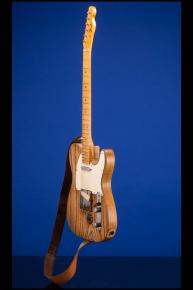Clarence White's other B-Bender Telecaster…
1968 Fender Telecaster (Clarence White 'B' Bender").
This unique 12 3/4-inch-wide 'Prototype' B-Bender Telecaster weighs just 8.00 lbs. and has a nut width of just under 1 5/8 inches and a scale length of 25 1/2 inches. Solid ash body, one-piece maple neck with a wonderful medium profile, and maple-cap fretboard with 21 frets and black dot position markers. Headstock with "Fender" logo in black with gold trim, "Telecaster" in black, and two patent numbers ("2,573,254 3,143,028") beneath "Fender." Single "butterfly" string tree. Individual Fender "F" tuners with six-sided metal buttons. The end of the neck is stamped "3 JAN 68B." Four-bolt Fender "F" neck plate with serial number ("245679") between the top two screws. One plain metal-cover 'black-bottom' pickup (at neck) with an output of 6.72k and one 'black-bottom' MusicMaster/DuoSonic pickup with cream plastic cover (angled in bridgeplate) with an output of 6.10k. The potentiometers are stamped "304 6631" (Stackpole, August 1966). Three-layer (white/black/white) plastic pickguard with eight screws. Two controls (one volume, one tone) plus three-way pickup selector switch, all on metal plate adjoining pickguard. Chrome knobs with flat tops and knurled sides and black plastic 'Top-Hat' switch tip. Fender combined bridge/tailpiece with three 'threaded' saddles. The neck has been expertly re-fretted with the correct 0.10 gauge fret-wire. There is some fret-wear and some light wear to the fret board. There is also some very old 'filler' around the jack input. Nothing has been touched on this guitar since the very early seventies when the guitar was acquired from Clarence White by a then working musician. Complete with the original embossed leather strap that came with the guitar. Housed in the 'original' (oversized) mid-sixties Fender 'Mustang Bass 'black hardshell case with black leather ends and red plush lining.
Sometime in the late 1960s, this early ’68 Maple-Cap Telecaster was customized into an early B-Bender.
According to guitarist Lee Fears, the legendary Clarence White of The Byrds and New Nachville sold it to him in the early 1970s during a recording session for Starlite Records in Pomona, California. Fears states that Clarence told him that his father and he built it.
While we take Mr. Fears at his word that he got it from Clarence, we’ve been unable to substantiate that it was built by White and his dad, who was a carpenter and musician.
But after talking to famed Byrds drummer, guitarist, and original b-bender designer Gene Parsons, Clarence White acolyte and to b-bender pioneer Bob Walford, and others, however, we have been able to clarify the origin of this very unusual instrument..
Responding to our inquiries, Gene Parsons, who designed and built Clarence White’s first B-Bender out of a late ‘50s Telecaster, told us: “This is a ‘one off bender’ done by a friend, Chuck Morgan, I believe, in the late sixties. He saw the one I did for Clarence and with my permission decided to do one himself.”
Chuck Morgan was a versatile sideman in country-rock, always, it seems, somewhere in the background, a drummer, keyboardist, and guitarist who played, recorded and toured with Delaney & Bonnie (drums); was keyboardist for New Nashville, the band that Clarence White co-founded; The Reasons, the group that succeeded New Nashville after its demise (keyboards); and with various country-rock bands as a guitarist.
In the late summer-early fall of 1973, Morgan, along with Gene Parsons and Clarence’s brother, Eric White, went on a brief tour to promote Gene's solo LP "Kindling."
Mr. Morgan appears to have dropped off the planet, last sighted in Alabama or Mississippi. Our attempts to track him down have failed.
The best evidence to date puts the origin of this guitar in the hands of Chuck Morgan, who 'customized' this axe, which, though crudely designed with a bending mechanism as simple as can be, and looks like hell, plays like heaven. The Music Master / DuoSonic pick-up that was substituted at its bridge has a lot to do with it’s bright tone.
Fred Stuart, who worked in the Fender Custom shop and was familiar with Clarence and involved with Fender’s ultimate manufacture of Tele B-Benders, tells us that the Music Master / DuoSonic pick-up at the bridge was Clarence White’s preference.
Whether Chuck Morgan integrated that pick-up at the behest of Clarence or on his own in emulation of Clarence’s sound is unknown. And, though highly plausible, whether Chuck Morgan gave it to his New Nashville bandmate Clarence White remains a mystery.
The likely, though tentative, chain of ownership is from Chuck Morgan to Clarence White to Lee Fears to us.
Wherever this amazing sounding ’68 Tele came from or who built it, it is without question one of the earliest B-Benders. Based upon its appearance, it was not meant to be played before an audience. This was an early attempt, a work in progress, an evolutionary step that led into a blind alley, a design that could not easily be mass-produced, and was buried by Gene Parsons’ engineering eureka, now the standard.
















